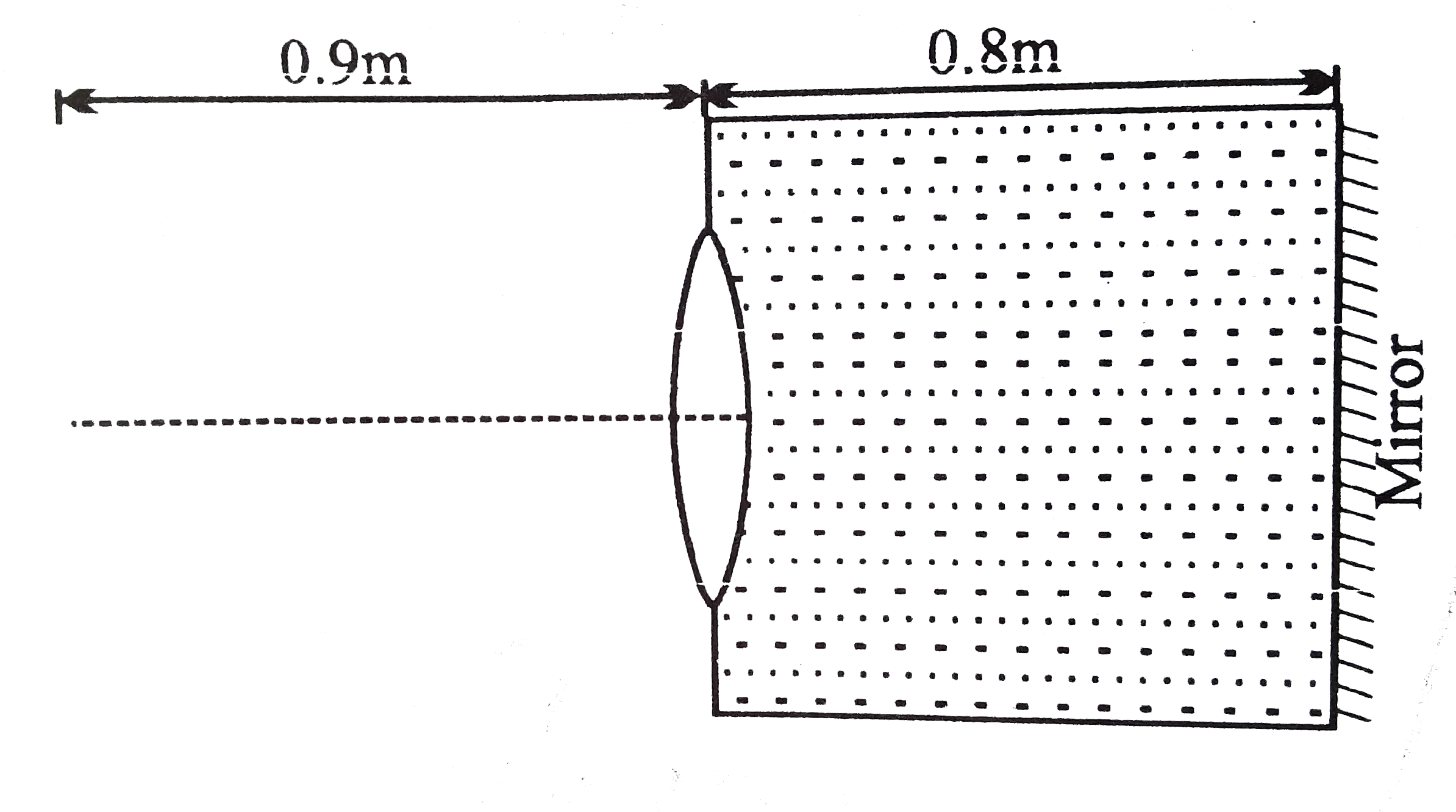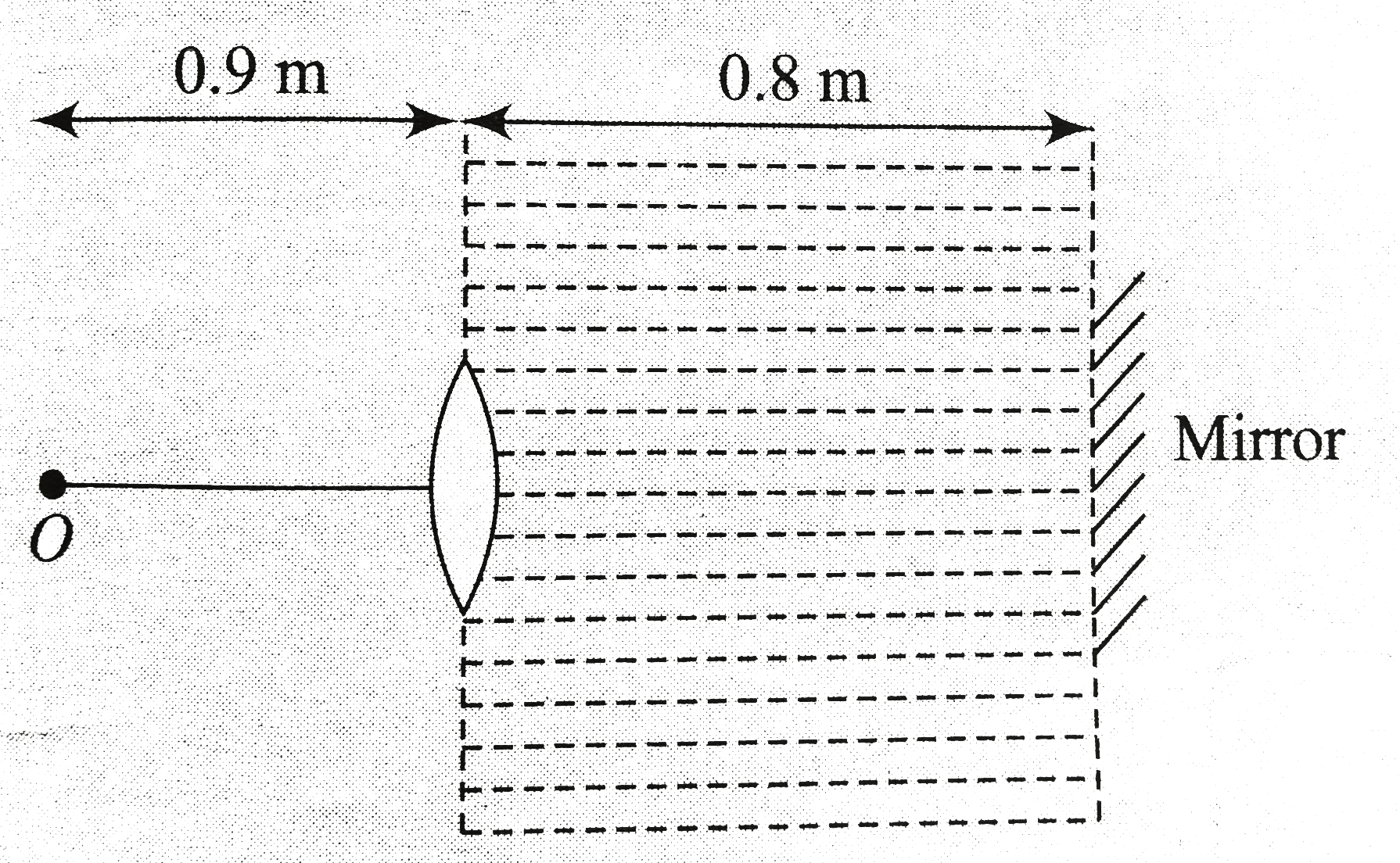A thin equiconvex lens of glass of refractive index μ=3/2 & of focal length 0.3min air is sealed into an opening at one end of a tank filled with water (μ=4/3) .On the opposite side of the lens ,a mirror is placed inside the tank on the tank wall perpendicular to the lens axis ,as shown in figure .the separation between the lens and the mirror is 0.8mA small object is placed outside the tank in front of the lens at a distance of 0.9m form the lens along its axis .Find the position (relative to the lens)of the image of the object fromed by the stsyem.

The correct Answer is:0.9 m from the lens (rightwards)
From the lens maker's formula
1f=(μ−1)(1R1−1R2)
we have 10.3=(32−1)(1R−1−R)
(Here R1=RandR2=−R) ∴R=0.3
Now applying μ2v−μ1u=μ2−μ1R at air glass surface , we get 3/2v1−1−(09)=3/2−10.3
∴v1=2.7m
i.e., first image I1 will be formed at 2.7 m from the lens. This will act as the virtual object for glass water surface.
Therefore, applying μ2v−μ1u=μ2−μ1R at glass water surface.
we have 4/3v2−3/22.7=4/3−3/2−0.3
∴v2=1.2m
i.e, second image I2 is formed at 1.2 m from the lens or 0.4 m from the plane mirror. This will act as a virtual object for mirror. Therefore , third real image I3 will be formed at a distance of 0.4 m in front of the mirror after reflection from it. Now this will work as a real object for water glass interface.
Hence applying μ2v−μ1u=μ2−μ1R
we get 3/2v4−4/3−(0.8−0.4)=3/2−4/30.3
∴v4=0.54m i.e. fourth image is formed to the right of the lens at a distance of 0.54 m from it. Now finally applying the same formula for glass air surface.
1v2−3/20.54−1−3/2−0.3 ∴vθ=0.9m
i.e., position of final image is 0.9 m relative to the lens frightwards or the image is formed 0.1 m behind the mirror.
Topper's Solved these Questions
- BOOK - ALLENCHAPTER - GEOMETRICAL OPTICSEXERCISE - EXERCISE-04[B]18videos
GEOMETRICAL OPTICS
- BOOK - ALLENCHAPTER - GEOMETRICAL OPTICSEXERCISE - EXERCISE-05 (A)35videos
GEOMETRICAL OPTICS
- BOOK - ALLENCHAPTER - GEOMETRICAL OPTICSEXERCISE - EXERCISE-312videos
GEOMETRICAL OPTICS
- BOOK - ALLENCHAPTER - CURRENT ELECTRICITYEXERCISE - All Questions427videos
CURRENT ELECTRICITY
- BOOK - ALLENCHAPTER - GRAVITATIONEXERCISE - EXERCISE 49videos
GRAVITATION
Similar Questions
A thin equiconvex lens of glass of refractive index μ=3/2 & of focal length 0.3min air is sealed into an opeing at one end of a tank filled with water (μ=4/3) .Ont he oppostie side of the lens ,a mirror is placed inside the tank on the tank wall perpendicualar tot he lens axis ,as shown in figure .the seperation bertween the lens and the mirror is 0.8mA small object is placed outside the tank in front of the lens at a distance of 0.9m form the lens along its axis .Find the position (relative to the lens)of the image of the object fromed byt he stsyem.
 View Solution
View SolutionA thin equiconvex lens made of glass of refractive index 3/2 and of focal length 0.3m in air is sealed into an opening at one end of a tank filled with water (μ=32). On the opposite side of the lens, a mirror is placed inside the tank on the tank wall perpendicular to the lens axis as shown in Figure. The separation between the lens and mirror is 0.8m. A small object is placed outside the tank in front of the lens at a distance oa 0.9m from the lens along its axis. Find the position (relative to lens) of the image of the object formed by the system.
 View Solution
View Solution
Knowledge Check
- Question 1 - Select One
A thin lens made of glass of refractive index μu=1.5 has a focal length equal to 12 cm in air. It is now immersed in water (μ=43). Its new focal length is
A48 cmB36 cmC24 cmD12 cm - Question 2 - Select One
An equiconvex lens of glass (μg=1.5) of focal length 10 cm is silvered on one side. It will behave like a
Aconcave mirror of focal length 10 cmBconvex mirror of focal length 5.0 cmCconcave mirror of focal length 2.5 cmDconvex mirror of focal length 20cm - Question 3 - Select One
A convex lens of focal length 15 cm and concave mirror of focal length 30 cm are kept their optical axes PQ and RS parallel but separated in vertical direction by 0.6 m, as shown. The distance between the lens and mirror is 30 cm. An upright object AB of height 1.2 m is placed on the optic axic PQ of the lens at a distance of 20 cm from the lens.

Find the linear magnification of the first image after refraction from the lens.A+3B−3C+2D−2
A thin equiconvex lens of glass of refractive side of 3/2 and of focal length 0.3 m is sealed into an opening at end of a tank filled with water (p=4/3). on the opposite side of the lens a mirror is placed inside the tank with the tank wall perpendicular to the sense axis as shown in figure
The separation between the lens and mirror is 0.8 m. A small object is placed outside the tank is front of the lens, at a distance of 0.9 m from the lens along its axis. Find the position (relative to the lens) of the image of the object formed by the system.
 View Solution
View SolutionAn equiconvex lens of refractive index μ2 is placed such that the refractive :
 View Solution
View SolutionA convex lens made of a glass of refractive index 3/2 has a focal length 'f' in air. If it is immersed into water of refractive index 4/3, then with calculation, predict the new focal length of the lens inside water.
View SolutionA glass convex lens of refractive index 32 has got a focal length equal to 0.3 m. Find the focal length of the lens if it is immersed in water of refractive index4/3.
View SolutionA thin lens made of a material of refractive index μ0 has a focal length f0 in air. Find the focal length of this lens if it is immersed in a liquid of refractive index μ.
View Solution
